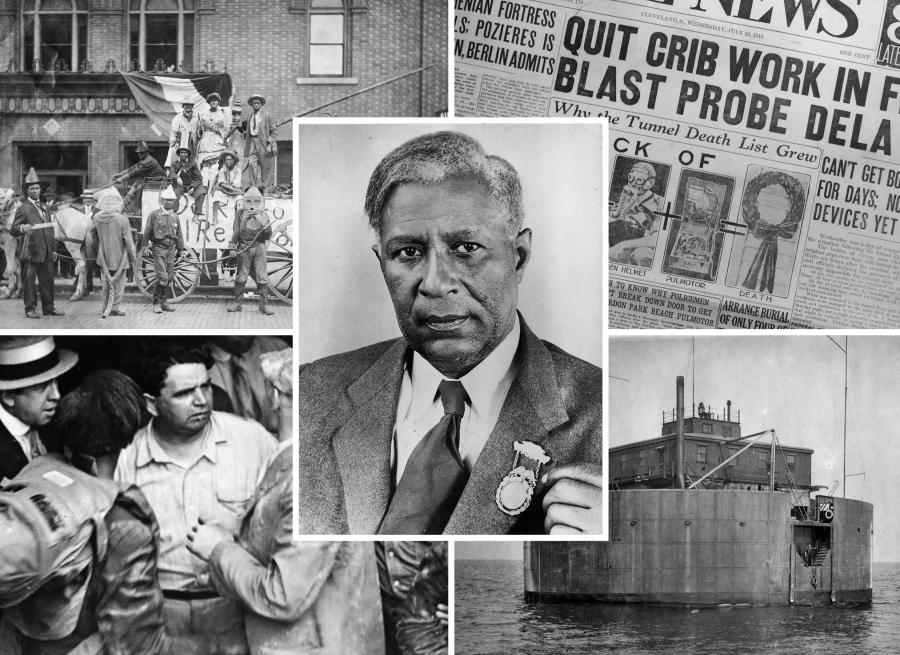Garrett Morgan and the History of Cleveland Water

Our Garrett A. Morgan Water Treatment Plant is named in honor of the Black inventor and entrepreneur who called Cleveland home. Morgan played an important role in the history of Cleveland Water and the plant that bears his name.
Cleveland’s First Water Works
The Garrett A. Morgan Water Treatment Plant is the oldest of Cleveland Water’s four treatment plants. Cleveland’s first municipal waterworks was opened on the same site on September 24, 1856.
Prior to then, residents’ water came from surface water and wells. As the city grew, so did the need for municipal water service. And in 1853, the City of Cleveland hired Theodore Scowden, a waterworks engineer from Cincinnati, to plan and supervise the project.
The system that Scowden designed consisted of an intake pipe located 300 feet from the shore of Lake Erie that fed water into a brick aqueduct. The aqueduct conveyed the lake water to a steam-powered pumping station. The water was then pumped into a nearby 6 million-gallon reservoir and distributed by gravity throughout the city via 11 miles of pipe. While the delivery method was improved, the water remained unfiltered and untreated.
Heroic Tunnel Rescue
As Cleveland’s population continued to grow, the demand for water increased. But a booming population and economy adversely affected water quality. The Cuyahoga River and Lake Erie shoreline became polluted, increasing rates of cholera and typhoid.
The city needed to find a way to improve the quality of water and distribute it to a larger area.
So in 1914, construction began on an intake tunnel 120 feet below Lake Erie that would be larger and extended farther offshore than any others that existed at the time, allowing for fresher, cleaner water to be delivered to Clevelanders. The tunnel would supply water to the city’s new Division Avenue Pumping and Filtration Plant.
On the evening of July 24, 1916, a natural gas pocket ignited causing an explosion in the tunnel below Crib No. 5, trapping workers inside and leaving 11 men dead. Two rescue parties were sent to search for survivors but 10 of the 18 rescuers succumbed to the gas in the tunnel and died, preventing further rescue attempts.
A policeman persuaded Cleveland authorities to contact Garrett A. Morgan. The officer had seen Morgan demonstrate a hood-like smoke protection device he invented for firefighters. The device was designed to draw air from foot level, where it's cleaner, through a tube and into a mask resembling a beekeeper's helmet.
As night became morning, Morgan and his brother Frank arrived with several of his smoke hoods. The Morgan brothers and two volunteers made four trips down into the tunnel, rescuing several men and recovering a number of bodies before officials stopped further rescue and recovery efforts.
Twenty-one men ultimately perished and at least nine others were injured. While Morgan’s heroism was overshadowed or altogether ignored at the time, it would eventually become a major part of his legacy. A legacy that also includes numerous inventions including the first three-position traffic signal.
The Division Avenue Plant was put into service in 1918, pumping filtered water to Cleveland residents for the first time. An engineering marvel of its time, the one-story, brick building was built with two wings, each housing 18 filters, administrative offices, and testing laboratories.
Honoring a Legacy
In 1991, the Division Avenue Station was renamed the Garrett A. Morgan Water Treatment Plant, in recognition of Morgan's role in rescuing men from the tunnel disaster and contributions to science and industry.
From 2001 to 2012, $177.2 million was spent on renovating the Morgan plant into a state-of-the-art water treatment facility. The improvements included a new finished water pump station, renovated filters, a new in-line rapid mix, a renovated Filter and Administration building, a renovated raw water pump station, installation of a plant-wide automation system, a new 15 million gallon reservoir, transition to a safer chlorine feed system, and the demolition of the old finished water pump building.
In 2016, Cleveland Water hosted a ceremony at the Morgan Treatment Plant to recognize the 100th anniversary of the tunnel disaster and subsequent rescue efforts.
The event honored those who lost their lives and recognized the heroism of Morgan and other volunteers who participated in the rescue effort. City of Cleveland officials joined descendants of the men who died during the disaster and rescue workers, many of whom met for the first time. Also in attendance was Sandra Morgan, the inventor's granddaughter. Ms. Morgan gave an emotional speech honoring her grandfather who died in 1963.
Today, the Garrett A. Morgan Water Treatment Plant pumps an average of 60 million gallons of water a day to the residents and businesses located downtown and in the western and southern suburbs of Cleveland and stands as a testament to the progress of water treatment and contributions of the Black community in Cleveland.
References
